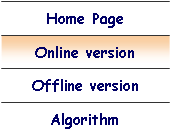
|
Hydrocalculator 1.03 |




|
Access to online version of the Hydrocalculator here the software is free of charge but simple registration is required allowing sending information about updates
The calculations require the user to enter data in three steps, and results are then displayed in the fourth step. Step 1: selection of the hydrological regime of the studied pool:
Step 2: selection of the option for dA value determination:
Step 3: entering analysed stable isotope composition of water: and measured parameters: T temperature; h relative humidity of air (as fraction); dA the stable isotope composition of moisture in ambient air (if known); dRain the stable isotope composition of precipitation (if dA is not known); LEL if known for the study area.
Step 4: After entering all required variables, the calculated results will be displayed as a fraction of the evaporated volume f, or as fraction evaporation over inflow E/I, depending on the selected model. Along with results, the intermediate parameters, calculated based on entered variables, will be listed: kinetic isotope fractionation constant Ck; kinetic isotope fractionation factor - εk; equilibrium isotope fractionation factor ε*, total isotope fractionation - ε, fractionation factor - a, limiting isotopic composition d* and parameter m.
Online version was designed by Adam Mydłowski following algorithm assembled by Grzegorz Skrzypek
|